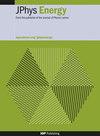Evaluating 3D printed mesh geometries in ceramic LiB electrodes
IF 6.3
3区 材料科学
Q1 ENERGY & FUELS
引用次数: 0
Abstract
Additive manufacturing techniques have the potential to promote a paradigmatic change in the electrode fabrication processes for lithium-ion batteries (LiBs) as they may offer alternative component designs to boost their performance or to customise the application. The present research work explores the use of low-cost fused filament fabrication (FFF) 3D printing to fabricate Li4Ti5O12 (LTO) mesh electrodes in the search for enlarged electrochemically active areas. Using different nozzle diameters (ND), we have 3D printed several mesh electrodes that after sintering allow an increase in the surface to volume ratio by up to ≈290% compared to conventional flat cylindrical geometries. As the conventional route to produce 3D printed meshes, i.e. stacking of consecutive layers with a 90° rotation, leads to problems of vertical misalignment that may affect the electrical contact, we have developed a new compact design that maximises the contact between layers. All the 3D printed mesh electrodes with thicknesses of 400 and 800评估陶瓷锂电池电极中的 3D 打印网格几何形状
增材制造技术有可能促进锂离子电池(LiBs)电极制造工艺的范式变革,因为它们可以提供替代组件设计,以提高电池性能或定制应用。本研究工作探讨了如何利用低成本的熔融长丝制造(FFF)3D打印技术制造Li4Ti5O12(LTO)网状电极,以寻找更大的电化学活性区域。通过使用不同的喷嘴直径(ND),我们三维打印出了几种网状电极,与传统的扁平圆柱形几何形状相比,烧结后的表面体积比最高可提高≈290%。生产三维打印网状电极的传统方法是将连续层堆叠并旋转 90°,这会导致垂直错位问题,从而影响电接触,因此我们开发了一种新的紧凑型设计,可最大限度地增加层间接触。所有厚度为 400 和 800 μm 的 3D 打印网状电极的电化学性能都非常接近薄型(70 μm)电极,例如,在 ND = 100 μm 的情况下,C/2 时的容量为 175 mAh g-1,这是 LTO 的理论容量值。在较高的 C 速率下,具有较大 ND 的 800 μm 厚网状电极的可逆容量明显下降(8 C 时为 28 mAh g-1),尽管所获得的值明显优于等效的厚固体电极(8 C 时几乎为零)。紧凑型设计在高 C 速率下表现出卓越的性能,在 800 μm 电极的 8 C 温度条件下,比最佳传统网状电极的结果提高了≈70%。这些结果凸显了 FFF-3D 印刷在生成新型高纵横比几何形状方面的潜力,以及设计和印刷参数对锂电池电极材料性能的影响。探索其他高效几何形状可能有助于将厚电极集成到高能量密度锂电池中。
本文章由计算机程序翻译,如有差异,请以英文原文为准。
求助全文
约1分钟内获得全文
求助全文
来源期刊

Journal of Physics-Energy
Multiple-
CiteScore
10.90
自引率
1.40%
发文量
58
期刊介绍:
The Journal of Physics-Energy is an interdisciplinary and fully open-access publication dedicated to setting the agenda for the identification and dissemination of the most exciting and significant advancements in all realms of energy-related research. Committed to the principles of open science, JPhys Energy is designed to maximize the exchange of knowledge between both established and emerging communities, thereby fostering a collaborative and inclusive environment for the advancement of energy research.
 求助内容:
求助内容: 应助结果提醒方式:
应助结果提醒方式:


